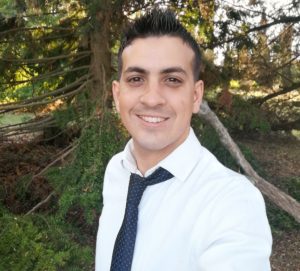 Gonzalo Scalese
Gonzalo Scalese
Exchange PhD Student
Chimie ParisTech
PSL University
CNRS
Institute of Chemistry for Life and Health Sciences
Laboratory for Inorganic Chemical Biology
+33 1 85 78 41 53
gscalese@fq.edu.uy
Gonzalo was born in southwestern Uruguay in 1993. He moved to Montevideo in 2011 to study at Universidad de la República. He obtained a Bachelor in Chemistry in 2016 and a Pharmaceutical Chemist degree in 2017. In 2013, Gonzalo joined the Medicinal Inorganic Chemistry research group led by Dinorah Gambino, focused on the rational design of new potential metallodrugs against parasitic and other prevalent diseases. He got a teaching assistant position at the Inorganic Chemistry Department, Faculty of Chemistry, at Universidad de la República in 2015 and started his PhD thesis entitled: “New heteroleptic vanadium complexes, potential antiparasitic agents” in 2017. In this frame, Gonzalo carried out research stays in Santiago de Chile (Diego Venegas’ Lab, 2017, Chile), Lisbon (Joao Costa Pessoa’s Lab, 2018-2019, Portugal) and Colorado (Debbie Crans’ Lab, 2021, USA).
Today he is involved in different research projects and particularly, he is part of an ECOS-Sud collaboration project between Uruguay and France, led by Gilles Gasser and Dinorah Gambino. For this project, Gonzalo is currently working at Chimie ParisTech in the Gasser Group. Gonzalo loves to travel, doing outdoor activities and he is into playing guitar and music.
Publications
[1] New silver(I) phosphino complexes: evaluation of their potential as prospective agents against Mycobacterium tuberculosis. Journal of Inorganic Biochemistry, 2022, 227, 111683, Y.Dolores Maldonado, G. Scalese, K. F. Manieri, F. R. Pavan, L. D. Aguirre, D. Gambino
[2] Heteroleptic oxidovanadium(V) complexes with activity against Infective and non-infective stages of Trypanosoma cruzi. Molecules, 2021, 26, 5375. G. Scalese; I. Machado; G. Salinas; L. Pérez-Díaz; D. Gambino.
[3] High throughput approaches to unravel the mechanism of action of a new vanadium-based compound against Trypanosoma cruzi. Bioinorganic Chemistry and Applications, 2020, DOI:10.1155/2020/1634270. F. Mosquillo; P. Smircich; A. Lima; S. A. Gehrke; G. Scalese; I. Machado; D. Gambino; B. Garat; L. Pérez-Díaz.
[4] Exploring oxidovanadium(IV) homoleptic complexes with 8-hydroxyquinoline derivatives as prospective antitrypanosomal agents. New Journal of Chemistry, 2019, 43, 17756-17773. G. Scalese; I. Machado; I. Correia; J. Costa Pessoa; L. Bilbao; L. Pérez-Díaz; D. Gambino.
[5] New heteroleptic oxidovanadium(V) complexes: synthesis, characterization and biological evaluation as potential agents against Trypanosoma cruzi. Journal of Biological Inorganic Chemistry, 2018, 23, 1265–1281. G. Scalese; I. Machado; C. Fontana; G. Risi; G. Salinas; L. Pérez-Díaz; D. Gambino.
[6] Heteroleptic oxidovanadium(IV) complexes of 2- hydroxynaphtylaldimine and polypyridyl ligands against Trypanosoma cruzi and prostate cancer cells. Journal of Inorganic Biochemistry, 2017, 175, 154 – 166. G. Scalese; F. Mosquillo; S. Rostán; J. Castiglioni; I. Ahlo; L. Pérez-Díaz; I. Correia; F. Marques; J. Costa Pessoa, D. Gambino.
[7] Evaluation of cellular uptake, cytotoxicity and cellular ultrastructural effects of heteroleptic oxidovanadium(IV) complexes of salicylaldimines and polypyridyl ligand. Journal of Inorganic Biochemistry, 2017, 166, 162 – 172. G. Scalese; I. Correia; J. Benítez; S. Rostán; F. Marques; F. Mendes; A. Matos; J. Costa Pessoa, D. Gambino.
[8] Expanding the family of heteroleptic oxidovanadium(IV) compounds with salicylaldehyde semicarbazones and polypyridyl ligands showing anti-Trypanosoma cruzi activity. Journal of Inorganic Biochemistry, 2015, 147, 116 – 125. G. Scalese; J. Benítez; S. Rostán; I. Correia; L. Bradford; M. Vieites; L. Minini; A. Merlino; L. Coitiño; E. Birriel; J. Varela; H. Cerecetto; M. González; J. Costa Pessoa; D. Gambino.
